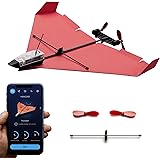The fascinating mechanics of the V-22 Osprey, as briefly illustrated in the accompanying video, represent a pinnacle of aerospace engineering. The inherent trade-offs between traditional rotorcraft and fixed-wing aircraft have long presented a formidable challenge to designers seeking to combine the best attributes of both. Helicopters excel in vertical takeoff and landing (VTOL) and hover capabilities, invaluable for austere environments or precision operations; however, their maximum forward speed is inherently constrained by complex aerodynamic phenomena such as retreating blade stall, which limits rotor tip speeds.
Conversely, conventional airplanes are engineered for high-speed, long-range flight, leveraging the efficiency of fixed wings at cruising altitudes. This configuration, however, necessitates runways for takeoff and landing, owing to the requirement for significant airflow over the wings to generate lift. The V-22 Osprey was conceived as the audacious solution to this fundamental dichotomy, embodying a revolutionary hybrid design. Its unique tiltrotor architecture effectively bridges the gap, allowing for operational flexibility previously considered unattainable within a single airframe.
The Ingenious Mechanics of Tiltrotor Technology
The core innovation behind the V-22 Osprey is its prop-rotor system, which is capable of rotating through a 90-degree arc. When operating in what is termed ‘helicopter mode,’ the large, three-bladed proprotors are tilted vertically, functioning much like conventional helicopter rotors. This orientation facilitates vertical ascent, descent, and hover flight, providing unparalleled access to constrained landing zones. The considerable downwash generated by these powerful rotors is a distinct characteristic of this mode, influencing ground operations and personnel.
As forward speed is desired, the V-22 transitions smoothly into ‘airplane mode’ by progressively tilting its engine nacelles and attached proprotors forward. This conversion process, expertly managed by a sophisticated fly-by-wire flight control system, reconfigures the aircraft from a rotorcraft to a turboprop airplane. The proprotors then function as highly efficient propellers, providing thrust for high-speed cruise, while the fixed wing generates the primary lift. This aerodynamic shift dramatically enhances the V-22 Osprey’s range and velocity capabilities, surpassing those of any traditional helicopter.
Operational Advantages and Strategic Imperatives of the V-22 Osprey
The strategic implications of the V-22 Osprey’s hybrid design are profound, particularly within military aviation. Its ability to perform VTOL operations, coupled with significantly extended range and speed, offers unparalleled operational flexibility. For instance, studies have indicated the V-22’s cruising speed, often exceeding 275 knots, is nearly double that of a conventional utility helicopter like the CH-46 Sea Knight, which it replaced in numerous roles. This speed advantage translates directly into reduced transit times and enhanced responsiveness for critical missions.
Furthermore, the Osprey’s combat radius and payload capacity are substantially greater than those of traditional rotorcraft. Analysis has shown that a typical V-22 mission can cover distances of over 300 nautical miles with troops and cargo, a capability that dramatically expands the reach of expeditionary forces. This enables the rapid insertion or extraction of personnel and equipment from locations inaccessible to fixed-wing aircraft, yet too distant for helicopters to reach efficiently. The V-22 has been instrumental in operations ranging from special operations to humanitarian relief, demonstrating its versatility.
Enhancing Expeditionary Warfare Capabilities
For maritime expeditionary operations, the V-22 Osprey represents a critical asset. It can launch from amphibious assault ships, bypass surface threats at high speed, and deliver troops directly to inland objectives. This reduces the time forces spend exposed to hostile fire and enhances the element of surprise. The V-22’s robust design also permits operation from austere forward operating bases, often requiring minimal ground support infrastructure. Its ability to operate effectively from both land and sea platforms underscores its unique value in modern defense strategies.
The advanced avionics suite integrated into the V-22 provides pilots with superior situational awareness, crucial for complex operational environments. Modern flight management systems, coupled with integrated navigation and communication systems, allow for precise mission execution in all weather conditions. This technological sophistication, while adding complexity, ultimately enhances safety and mission success rates, especially during high-stakes military deployments. The capacity to carry a significant number of troops or substantial internal and external cargo further solidifies its role as a premier military transport aircraft.
Engineering Complexities and Developmental Hurdles
The realization of the V-22 Osprey’s revolutionary design was not without considerable engineering challenges and developmental hurdles. Integrating the capabilities of a helicopter and an airplane into a single airframe introduced unprecedented complexities, particularly in areas such as structural integrity, propulsion system synchronization, and flight control. The immense forces generated by the large proprotors during conversion and high-speed flight demanded innovative material science and structural design to ensure the airframe’s durability and fatigue life.
A highly sophisticated digital fly-by-wire flight control system was developed to manage the intricate aerodynamics across the V-22’s vast flight envelope. This system continuously adjusts control surfaces and rotor pitch to maintain stability and controllability during all phases of flight, especially during the critical conversion from vertical to horizontal flight. Issues such as “cross-coupling” between control axes, inherent in such a hybrid design, required extensive software development and rigorous testing. Early developmental challenges and incidents were exhaustively investigated, leading to significant design refinements and safety enhancements over decades of iteration.
Overcoming Aerodynamic and Control System Challenges
The transition between helicopter and airplane modes presented unique aerodynamic challenges that necessitated advanced computational fluid dynamics and extensive wind tunnel testing. Managing the aerodynamic interactions between the wing and the proprotors, particularly during the conversion corridor, was a primary concern. The control laws needed to be robust enough to handle the varying thrust vectors, lift profiles, and moments generated as the nacelles rotated, all while providing predictable and intuitive pilot inputs. This level of integration was, and remains, a monumental achievement in aerospace engineering.
Moreover, the engine and transmission systems for the V-22 are exceptionally complex, designed to power two large tilting proprotors while also providing power for the fixed-wing flight. The requirement for a robust interconnection driveshaft, capable of transferring power between the two proprotors even if one engine fails, highlights the redundancy built into the system. This cross-shafting capability ensures continued controlled flight even under critical single-engine conditions, a testament to the safety-critical design philosophy that was employed throughout its development cycle.











